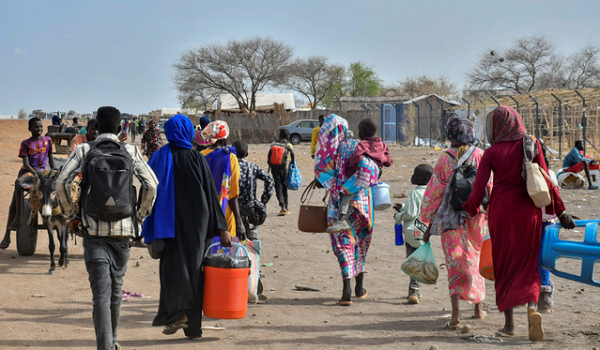Ottawa ready to bring in thousands of Sudanese, but the new pathway raises questions
In the terrifying months after the war in Sudan erupted, Kholoud Abakar and her children abandoned their home five times, moving from city to city in the devastated country in a race for survival.
Now, her Canadian family is fighting to get her and her seven children to safety in Canada. But even as Ottawa prepares a new family-reunification pathway to help thousands of Sudanese reach this country, restrictions in the rules could dash the hopes of Ms. Abakar and many others like her.
On Tuesday, the federal government is set to launch a program for up to 3,250 Canadian citizens and permanent residents to sponsor relatives in Sudan to enter Canada.
“This humanitarian pathway will help reunite loved ones and save lives,” Immigration Minister Marc Miller said in his announcement in December.
However, Sudanese Canadian community leaders say the program is inadequate in the face of the huge needs. Sudan has become the world’s biggest displacement crisis, with a staggering eight million people forced from their homes in the past 10 months, according to United Nations agencies.
“I don’t think people understand the scale of the problem,” said Sami Atabani, the Canadian brother of Ms. Abakar, who is trying to bring her and her children to Canada. He believes there should be a higher cap on the number of applicants.
“Everyone should have an equal opportunity to bring their family to Canada,” he told The Globe and Mail. “How can you discriminate between two different families? If I’m the applicant number 3251, I’m put at a disadvantage compared to other Sudanese Canadians who applied a day earlier.”

When war exploded between the Sudanese army and the paramilitary Rapid Support Forces last April, his sister and her family were living in Omdurman, across the Nile River from the capital, Khartoum. They moved twice as the fighting came closer. Then they fled to the southern city of Wad Madani, where thousands of displaced people had found shelter. But in December, the RSF attacked the city, killing and looting.
Ms. Abakar is a Darfuri, from a region where the paramilitary fighters have massacred thousands of people: “If she falls into the hands of the RSF, I have no doubt she’ll be dead,” Mr. Atabani said.
She and her children finally escaped Wad Madani in the middle of the night, crossing a river, walking 40 kilometres and then taking a bus to Gedaref, further south.
Now they have moved to Port Sudan, in the north. But under the Canadian program, they still face obstacles. They must provide biometric data such as fingerprints, which cannot be done in Sudan. Traveling to a neighbouring country such as Egypt is arduous and expensive. Even the simple task of obtaining Sudanese passports for Ms. Abakar’s children has been daunting in the wartime chaos.
Another issue is Ms. Abakar’s family status. Her mother died from childbirth complications a few days after her birth in 1979, and Mr. Atabani’s parents raised her as their child. But legal adoption was difficult because of Sudan’s complex adoption laws. Her brother hopes Canada will recognize her as their relative.
A third problem is an age limit of 21 for dependents of siblings under the program. This would rule out Ms. Abakar’s oldest children, and she will not leave any of her children behind, Mr. Atabani said.
The cap of 3,250 applications is yet another key issue. The program allows applications for anyone living in Sudan, which includes people of many nationalities, such as large numbers of Ethiopian and Eritrean refugees who had fled to the country before the war. It is unclear how many spots will be allocated for Sudanese citizens.
The Sudan program has some similarities to a separate Canadian pathway for family sponsorship for 1,000 Palestinians in Gaza, announced last month. More than 1,400 Canadian individuals and organizations have signed an online petition calling the Sudan and Gaza programs “inadequate and discriminatory.”
Julie Lafortune, a spokesperson for Immigration, Refugees and Citizenship Canada, said she cannot speculate on whether the cap on applications might be increased.
“When responding to international crises, there are often similarities in that people may be fleeing instability of some sort, but the immigration responses are tailored to each different context to meet the unique needs of those who require our support,” she said.
She did not respond to questions about the age limit. But she defended the decision to include non-Sudanese people in the program: “Sudan hosts one of the largest refugee populations in Africa.”
Mr. Atabani has struggled to help his sister since the war began. He even picketed the Canadian High Commission in London, where he lives, to plead for help. He says the Canadian staff largely ignored him – except to call the police to question him.
Despite sending frequent messages to Canadian officials and politicians, he has gotten few answers: “I feel very let down,” he said.
Tariq Kamil, a 54-year-old Sudanese Canadian, hopes the new program will allow him to bring his mother to Canada. He managed to get his family from Sudan to Egypt after the war began, and then Canada allowed him to bring his wife and children to the country a few months later, under temporary new rules.
But his mother was deemed ineligible and had to be left behind, despite their closeness: “We used to live in her house and we are so attached to each other,” Mr. Kamil said.
While he welcomes the family-reunification program, he worries about the cap on applications and the steep financial requirements for sponsorship.
Ashraf alTahir, president of the Sudanese Canadian Communities Association, said the Canadian program offers “a slim window of hope.” He is urging the government to remove the cap on applicants and ease some of the financial red tape for sponsorships.
Mr. alTahir and other Sudanese Canadian leaders have also been pushing the government to scrap the age restriction on dependents of siblings – especially for women, who face a rising risk of sexual violence in Sudan. Humanitarian agencies have already documented many sexual assaults by soldiers in the war.
“The main priority for so many people right now is to get the female members of their families out of this war zone,” Mr. alTahir said. “They are prime targets of militias … no one will ever make a decision to leave, seeking refuge and peace in Canada, and leaving his daughter behind.”
He sees the family program as “only the first step.” The logical next step, he said, is a broader refugee program, as Canada has done for other wars.
Ranya Elfil, former president of a Sudanese Canadian community association in Mississauga, said many community members are worried by the cap on applications.
“People are not in a safe situation, they’re in war zones and their lives are at risk,” she said.
Ms. Elfil is seeking greater flexibility on the requirements for identity documents and biometrics: “People left their homes with only the clothes on their back. They didn’t have documents.”
But the biggest problem, she said, is simply the lack of knowledge in Canada about the massive scale of the Sudan war.
“People look at it as normal – just another war in Africa. This has been our nightmare since this war began: getting attention. We are doing this fight alone.”
This article was reported by The Globe and Mail











